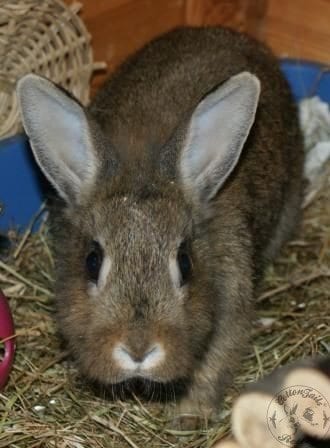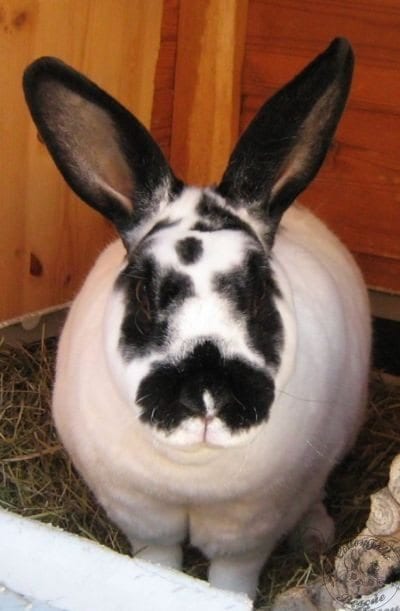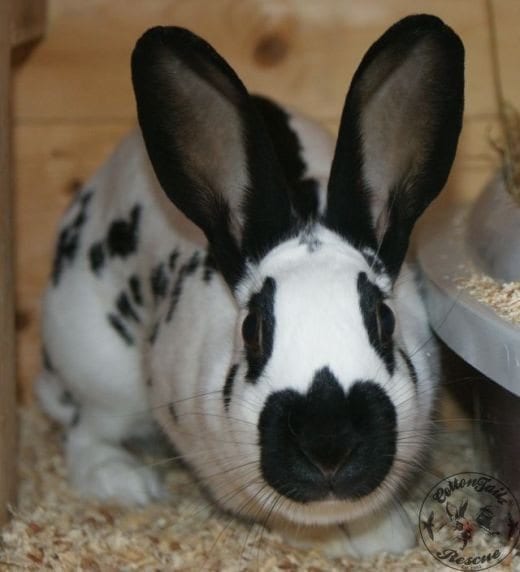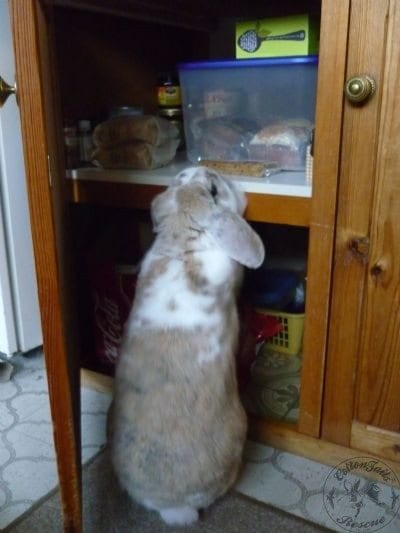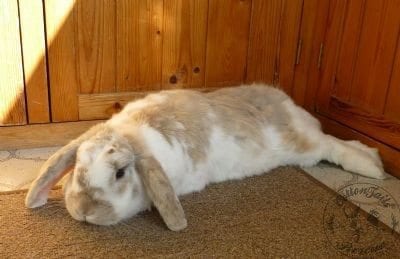Rabbits are not what they seem. Under that cute, furry exterior lurks a determined, self-motivated little devil that has the potential to be aggressive and sometimes downright horrid!
Unlike dogs, rabbits have never learnt that their well-being depends on their owner providing them with food and shelter, and therefore they give the accurate appearance of being selfish – they don’t care a bit if they attack the hand that feeds, their only aim is to get what they want at that particular time.
Furthermore, a rabbit’s nature is not dependent upon how much it is handled as a baby, nor is it safe to assume that because a rabbit is nasty it must have had a bad experience in the past.
The nature of a rabbit appears to be “set” very early on via hereditary genes, and although external experiences may “bend” a personality somewhat, the basic nature of the rabbit will become apparent at between 4-6 months of age for good or bad, whether we like it or not. Generally speaking, rabbits calm down as they get older, often becoming more placid at about 3-4 years. However, severe aggression in rabbits must not be taken lightly. I have personally seen the wounds on an owner’s face inflicted by a vicious house rabbit that leaped off a chair and attacked her – she needed five stitches in her face and will require cosmetic surgery to hide the scars.
Some rabbits show aggression as a result of fear, more a defensive aggression than an out-and-out nastiness, and such rabbits can be turned around with appropriate action such as neutering to remove any hormonal component, using appropriate accommodation such as a large hutch with a run permanently attached so that the rabbit does not have to be handled at all if it does not want to be picked up, and matching up with an opposite sexed neutered rabbit that is compatible. Used together, these steps can transform a rabbit completely into a creature that is relaxed and content.
However, there are a small minority of rabbits for which nothing seems to work, and even basic cleaning and feeding of an aggressive rabbit can be problematic. Such rabbits will often lunge at the brush, dustpan, hand or whatever is used to lift the soiled bedding out of the cage. This can be rather disconcerting! What can be even trickier is trying to retrieve the food dish in order to put fresh food in, and sleight-of-hand is required to replace the filled bowl back in the hutch. I have made two short films illustrating how to go about managing a “food anxious” rabbit:
Another technique that may work with a food anxious rabbit is not to put the food in a bowl at all, but to scatter the day’s allocation all over the area that the rabbit is allowed to be in. This removes any associations with food bowls and hands, and means the rabbit has to forage for its food rather than literally getting it handed out on a plate. You must be sure, however, that you do not use this as an excuse to overfeed!
Let’s take a closer look at what keeping a grumpy or aggressive rabbit is really all about, starting with the boys!
Aggression in male rabbits is usually an inherited condition, a predisposition to this type of behaviour being passed on from parent to offspring. By aggression I mean severe open mouth biting in and out of the hutch, rearing up in an attempt to bite one’s hand often accompanied by lunging with the fore feet. Growling and grunting is often heard during these episodes.
This pattern of behaviour should not be confused with frustrated sexual “courtship” whereby a male rabbit will circle an object, whether it is your hand, your feet, or whatever, often accompanied by gentle grunting noises, followed by “nipping” (not biting), mounting, and possible spraying of urine. This latter behaviour is usually rectified by castration, a very straightforward veterinary procedure now considered routine. See separate article on neutering.
Unfortunately, the first type of behaviour i.e. inherited, is not usually helped by castration, which leaves the owner with a dilemma, although there are various viable options for coping with such a rabbit. Often simply not handling a grumpy rabbit unless absolutely necessary is enough to calm things down and let him gain trust and confidence in the fact that he is not going to be hauled out of the hutch or pen every time someone approaches. This is fairly reasonable when you come to think of it, as most rabbits do not like being handled much anyway and would rather be running around on the floor! Bear in mind that it is instinctive for a rabbit to associate being held by a person with being in the jaws of a fox and about to die. When you look at the situation that way, it then becomes obvious why the vast majority of rabbits do not like to be handled.
Another alternative with an extremely aggressive male is to have him castrated anyway and match him up with a neutered female. This sharing of the territory often improves an aggressive male’s behaviour. However, take advice from someone experienced in the art of bunny match-ups as this process is not as straightforward as one may think. Although a stimulating environment should be provided for all rabbits by giving them toys, cardboard boxes and other suitable items, this in itself rarely improves the temperament of an aggressive rabbit, indicating that the problem is not just down to boredom.
Take precautionary measures such as wearing a thick jumper or coat if you absolutely have to handle the rabbit, and in severe cases it may be necessary to wear gardening gloves when cleaning out. Using two food bowls can help, placing the bowl with the fresh food into the hutch and whilst the rabbit is distracted by eating, remove the empty one. Also try the food scattering idea as discussed above. Additionally, if you have not already done so, place the hutch inside an enclosure or attach a large run to the hutch so that the rabbit does not need to be handled for exercise purposes, also enabling one to clean out the hutch whilst he is out running around.
The girls!
Female rabbits, by comparison, are more straightforward as most of their aggressive behaviour is hormone driven and as a result usually responds well to spaying. The added advantage of neutering a female rabbit is that it also protects her from uterine cancer and associated problems – responsible for up to 80% of deaths in older female rabbits. However, spaying on its own is sometimes insufficient to completely resolve the aggressive tendencies in females, and the same procedures as suggested for males should be attempted.
It is not uncommon to find that during the early part of the year a normally manageable female suddenly becomes grumpy and aggressive. This is a result of the lengthening daylight and possibly a general increase in temperature, which is a trigger in wild rabbits to mark the start of the breeding season. Even spayed females can react in this way, as the pineal gland in the brain reacts to the increase in day length to stimulate a change in behaviour independently of whether they are neutered or not. The good news is that this phase does not last very long, and usually after a month or so the rabbit will return to normal again. Neutering will help, however, as although it will not prevent the mood change from happening entirely, it will make the change less extreme. Not all rabbits are affected, but enough of them are, to justify the inclusion of this information here.
Sadly, if everything has been tried unsuccessfully, sometimes one has to admit defeat and consider having the rabbit put to sleep. This may seem a very heartless course of action and naturally should not be contemplated without much thought and consultation with the vet, but unfortunately there is sometimes no real choice, as it is not an option to pass on such a rabbit to someone else.
Strangely enough, it can be those rather grumpy individuals that can show the most affection in the right circumstances and environment, especially if allowed to come into the house. However, having a house rabbit does not suit everyone, nor does it solve all problems, but it may well be worth a try so long as it is feasible and there are no young children in the household who could be put in potential danger.
The case of Rumple, a very large neutered male, illustrates this point well. He arrived extremely overweight and very dirty at the back end due to far too much dried food and no exercise. To start with he was passive and subdued, but as time went on he has showed his true nature, which was grumpy and unpredictable! He could be enjoying being stroked one minute, and then be a raging charging bull the next, and because of this I was starting to think he was not suitable for adoption. Cue kind experienced rabbit enthusiast to the rescue in the form of Maggie! Maggie visited at the weekend with a pile of newspapers for us, and I happened to mention about Rumple and his issues, and she bravely suggested that if I really felt he was not rehomable she would take him on trial as a house bunny and see what she could do. She was as good as her word and that night Rumple was unceremoniously herded into a carrier to start his “on trial” period. Maggie sent her first update within a few days:
Hi Mairwen,
So far so good. Rumple such a little character he’s only bitten me once, well twice actually but I’m learning to watch for triggers, which seem to be around his food bowl. Both times he has gone for me when putting dry food in his bowl, He gets very excited when he thinks foods coming, so I now distract him with a little green stuff, which strangely he will let me feed by hand? Then I put dry food in bowl while he’s munching, thus avoiding losing my fingers! It’s only been a few days, he has settled well considering, actually comes to me and I give him a little stroke/fuss which he appears to like, I’ve not been brave enough to attempt picking him up yet, still hoping to gain his trust first with sitting with him, and his coming to me. I have a child-gate between my kitchen/lounge, which sometimes being lazy I step over instead of opening to walk through. Interestingly Rumple doesn’t like me stepping over it, but O.K. if I walk through, seems to re-enforce the dislike of ‘things’ above him, I also make a point of going ‘down’ to his level when feeding him greens and when he comes to me for attention, seems happy with that. I will let you know of our progress, he gave me a little lick this morning on my hand – bless! Yeah, the lunges and growls, one bite bit scary, but that was all on Thursday, Rumple has been fine since, with none of that at all since, so just watching for ‘triggers’, which hopefully we can avoid, to prevent aggression. Maggie, Rumple, Rufus and Lily.xxxx
Maggie then sent another update around 3-4 weeks later:
Hi Mairwen,
Rumple is doing very well settling in here has taken over my kitchen made it his own even found the food cupboard as you can see! His behaviour is really good I get the odd snort or growl, but only at food times I’ve found if I distract him with a little something green I can put his dry food in his bowl without a lunge or any aggression at all. I think being in the house not in a hutch means so far, he is not showing any territorial tendencies and accepts the kitchen is my space too, so we get along fine. He lets me stroke him, brush him (moulting like anything!) even give him kisses, though he’s not sure about the ‘slushy’ stuff, must be a man! I’ve taken a few photo’s of him, I don’t believe he was the bunny you described to me, unless he’s a wolf in sheep’s clothing! Love Maggie Rumple Rufus and Lily X
For further information about rabbit welfare issues, contact CottonTails® on 01373 864222.

